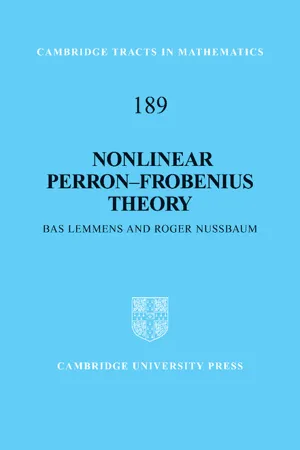
- English
- PDF
- Available on iOS & Android
Nonlinear Perron–Frobenius Theory
About this book
In the past several decades the classical Perron–Frobenius theory for nonnegative matrices has been extended to obtain remarkably precise and beautiful results for classes of nonlinear maps. This nonlinear Perron–Frobenius theory has found significant uses in computer science, mathematical biology, game theory and the study of dynamical systems. This is the first comprehensive and unified introduction to nonlinear Perron–Frobenius theory suitable for graduate students and researchers entering the field for the first time. It acquaints the reader with recent developments and provides a guide to challenging open problems. To enhance accessibility, the focus is on finite dimensional nonlinear Perron–Frobenius theory, but pointers are provided to infinite dimensional results. Prerequisites are little more than basic real analysis and topology.
Frequently asked questions
- Essential is ideal for learners and professionals who enjoy exploring a wide range of subjects. Access the Essential Library with 800,000+ trusted titles and best-sellers across business, personal growth, and the humanities. Includes unlimited reading time and Standard Read Aloud voice.
- Complete: Perfect for advanced learners and researchers needing full, unrestricted access. Unlock 1.4M+ books across hundreds of subjects, including academic and specialized titles. The Complete Plan also includes advanced features like Premium Read Aloud and Research Assistant.
Please note we cannot support devices running on iOS 13 and Android 7 or earlier. Learn more about using the app.
Information
Table of contents
- Cover
- CAMBRIDGE TRACTS IN MATHEMATICS
- GENERAL EDITORS
- Title
- Copyright
- Contents
- Preface
- 1 What is nonlinear Perron–Frobenius theory?
- 2 Non-expansiveness and nonlinear Perron–Frobenius theory
- 3 Dynamics of non-expansive maps
- 4 Sup-norm non-expansive maps
- 5 Eigenvectors and eigenvalues of nonlinear cone maps
- 6 Eigenvectors in the interior of the cone
- 7 Applications to matrix scaling problems
- 8 Dynamics of subhomogeneous maps
- 9 Dynamics of integral-preserving maps
- Appendix A The Birkhoff–Hopf theorem
- Appendix B Classical Perron–Frobenius theory
- Notes and comments
- References
- Symbols
- Index